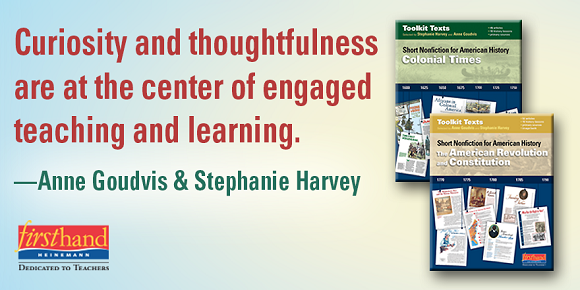The second resource in the Toolkit Texts series, Short Nonfiction for American History, releases this week. In several blogs over the next few weeks, coauthors Anne Goudvis and Stephanie Harvey share their perspectives and insights into historical literacy.
The second resource in the Toolkit Texts series, Short Nonfiction for American History, releases this week. In several blogs over the next few weeks, coauthors Anne Goudvis and Stephanie Harvey share their perspectives and insights into historical literacy.

by Anne Goudvis and Stephanie Harvey
At this very moment, calls for increased rigor and content-rich curriculum reverberate from coast to coast. Yet too many schools and districts—particularly in the elementary and even middle grades—have put history and social studies on the back burner. The laser focus on high-stakes testing in math and reading has pushed social studies and history into an ever smaller corner of the school day or, astonishingly, they’ve been abandoned all together.
The study of history and social studies should not be optional in a democracy!
How will our students ever participate fully and thoughtfully in the democratic process if they have little time to learn how that process has worked in the past? To build knowledge and understanding—to become literate in the discipline of history—students should be reading and learning about the stories, mysteries, questions, controversies, issues, discoveries, and drama that are the real substance of history.
Unfortunately, the default history curriculum is often reduced to a passive slog through the textbook that focuses on kids’ answering the questions at the end of the each chapter. In states with high-stakes history tests, teachers are responsible for “covering” a long list of facts, a curriculum that’s a mile wide and an inch deep.
The study of history and social studies should not be optional in a democracy!
What to do? We merge foundational literacy practices with engaging, authentic, relevant resources. As kids read, listen, and view, we encourage them to ask lots of questions; these are the best entry points for beginning to think like historians! Most important, we create a “minds on” classroom environment by focusing on big ideas and compelling issues. As kids discuss, agree, disagree, and take a stand, they are actively thinking and building their store of knowledge.
We flood the room with rich resources that kids can sink their teeth into: artifacts, images and visuals, primary sources, videos, historical fiction, journals and letters, even plays depicting historical events. As Diane Ravitch says, history is all about “stirring events, colorful personalities, and riveting controversies.” In this series of blogs, we’ll answer the question, What does teaching for historical literacy look like? We’ll share several instructional practices that immerse kids in historical ideas and information and spark their curiosity about the past so they can more fully understand the present. Wary of history taught as a dull recitation of dates and facts, we keep this mantra in mind: Curiosity and thoughtfulness are at the center of engaged teaching and learning.
Click here for more information on the new Short Nonfiction for American History.
♦ ♦ ♦ ♦
Anne Goudvis and Stephanie Harvey have enjoyed a fifteen-year collaboration in education as authors and staff developers. They are coauthors of the Heinemann title Comprehension Going Forward and of Strategies That Work. They have also created a family of bestselling classroom materials under Heinemann’s firsthand imprint: The Comprehension Toolkit, The Primary Comprehension Toolkit, Toolkit Texts, Comprehension Intervention, Scaffolding for ELLs, and Connecting Comprehension and Technology. Their newest resource, Short Nonfiction for American History, is discussed in this blog post.


